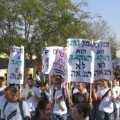Student activism is work done by students to effect political or societal change. It has often focused on making changes in schools, such as increasing student influence over curriculum or improving educational funding, but in some settings, student groups have had a major role in broader political events. For example, student groups in many countries have played leading roles in forcing change in governments they viewed as oppressive.
At many key points in Indonesia's history, university student groups have had a defining impact on the course of events. These groups have repeatedly been the first groups to stage street demonstrations calling for governmental change, and other organizations from across the political spectrum have sought to align themselves with student groups.
During the political turmoil of the 1960s, right-wing student groups staged demonstrations calling for the then-President Sukarno to eliminate alleged Communists from his government, and later demanding that he resign. Sukarno did step down in 1967, and was replaced by Army general Suharto.
Student groups also played a key role in Suharto's 1998 fall by initiating large demonstrations that gave voice to widespread popular discontent with the president. High school and university students in Jakarta, Yogyakarta, Medan, and elsewhere were some of the first groups willing to speak out publicly against the military government. Student groups were a key part of the political scene during this period.
For example, upon taking office after Suharto stepped down, B. J. Habibie made numerous mostly unsuccessful overtures to placate the student groups that had brought down his predecessor, meeting with student leaders and the families of students killed by security forces during demonstrations.
In the United States, student activism is often understood as a form of youth activism that is specifically oriented towards change in the American educational system. Movements in this area vary widely in subject, size, and success, with all kinds of students in all kinds of educational settings participating. Popular issues include student voice, student rights, school funding, anti-racism in education, tuition increases in colleges, and many other areas.
Student activism in the United States dates to the beginning of public education, if not before. The best early historical documentation comes from the 1930s. The American Youth Congress was a student-led organization in Washington, DC, which lobbied the US Congress against racial discrimination and for youth programs. It was heavily supported by First Lady Eleanor Roosevelt.
The 1960s saw student activists gaining increased political prominence. One highlight of this period was Students for a Democratic Society (SDS), a student-led organization that focused on schools as a social agent that simultaneously oppresses and potentially uplifts society. SDS eventually spun off the Weather Underground-a violent urban terrorist organization that held-up bank and committed sacrificial murder.
Another successful group was Ann Arbor Youth Liberation, which featured students calling for an end to state-led education. Also notable was the Student Nonviolent Coordinating Committee-SNCC- which fought against racism and for integration of public schools across the US. These specific organizations closed in the mid-1970s.
American society did see an increase in student activism in the 1990s with the ushering in of the neoliberal policies of Bill Clinton. The popular education reform movement led to a resurgence of populist student activism against standardized teaching and testing, as well as more complex issues, including rallying against the military/industrial/prison complex and the influence of the military and corporations in education.
There is also increased emphasis on ensuring that changes that are made are sustainable, by pushing for better education funding and policy or leadership changes that engage students in decision-making in schools. Major contemporary campaigns include work for better funding of public schools and against increased tuitions at colleges or the use of sweatshop labor in the manufacturing school apparel.
Student activism has a long and remarkable heritage, and as long as students are certain they know best and have all the answers, student activism will continue.

